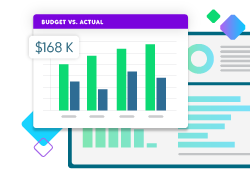Improve Efficiency and Mitigate Risk with AP Automation for Nonprofits

Accounts payable (AP) is one of the most task-heavy parts of your finance team’s workload. According to the AFP’s 2022 Payments Cost Benefit Survey, most finance professionals spend at least one hour a week on each of these tasks: reconciling payments, processing ACH payments, and processing checks. That’s more than 150 hours—almost 19 business days—each year. And some organizations are spending up to six hours a week on each of those tasks.
But what if you could automate some of these processes and free up your finance team to focus on more strategic work? What if you could improve efficiency and mitigate risk with automated accounts payable?
Here’s how automated payments work in fund accounting and how they can benefit your nonprofit organization.
Understanding Automated Payments in Fund Accounting
Automated payments are the next step in AP. They use pre-established pathways with individual vendors to match and pay expected invoices directly and seamlessly. Incorporating automated payments into your fund accounting processes removes many of the manual and costly processes that have plagued finance teams for years.
The process behind automated payments is similar to what finance teams follow today, but some of the steps are done by the system—reducing time for processing and resulting in faster payments.
Here’s how it works:
- Set up an operating account, where you want funds pulled from to pay the invoice, and a custodial account, the account the invoices are paid from.
- Select the invoices you want to pay.
- Run the payments through your normal approval workflows. Money to cover those expenses is transferred from your operating account into the custodial account.
- The first time you submit an invoice for a vendor, the payment vendor will connect with each one to determine the preferred form of payment for each payee.
- Invoices are paid, with a clear trail in the system for tracking.
Fund Accounting Software that Drives Impact
Find out how Blackbaud’s Financial Edge NXT® fits your organization.

Benefits of AP Automation for Your Nonprofit
Here are some of the benefits you’ll see by incorporating automated accounts payable into your fund accounting processes.
Fewer Touches on Invoices
An automated payments system moves an invoice from approved to paid quickly and with only necessary human interaction.
This means you can:
- Reduce the need to match invoices to expenses—the system does it automatically. Most automated payments systems can match up to 60% of expected invoices. As the system gets better at recognizing your payments, potentially all payments could be matched automatically.
- Eliminate the need to print, sign, or mail checks, saving time and money.
- Reduce human errors and discrepancies. Fewer human touches mean fewer errors and more accurate and on-time payments.
No More Tracking Down Updated Payment Information
Limit the support calls from vendors and late fees by getting in front of changes to vendor payment information.
With an automated payment system, you can:
- Let the payment vendor reach out to each vendor you want to pay and verify their preferred payment process. Even though you’ve been sending checks, you may find that vendors prefer ACH or a credit card payment.
- Let the payment vendor reach out when there is a return, or if a payment hasn’t been deposited within a certain time frame to make sure there haven’t been any changes.
- Keep your vendor information up to date and accurate so you can pay your vendors faster and avoid late fees.
Your Account Information Stays Secure
Your custodial account keeps your operating account information off payments, limiting your exposure if your vendors experience a security breach.
By using more digital payment methods, you can:
- Reduce the risk of check fraud, which is still the most common type of payment fraud, according to a joint study by AFP and JPMorgan.
- Protect your account and routing numbers from being left in a mailbox or on someone’s desk—where they could get stolen or lost.
Identify Issues Faster
Shorter reconciliation time, more transparency, and real-time tracking means you can identify potential fraud sooner and address potential vulnerabilities before they create more issues.
By using automated payments, you can:
- Monitor your payments and cash flow in real time. You don’t have to wonder when the check will be deposited.
- Get alerts and notifications for any anomalies or exceptions so you can resolve issues quickly and efficiently.
- Improve your audit readiness and reporting with more accurate and up-to-date information.
Free Up Your Finance Team to Focus on More Strategic Work
All automation requires human oversight. But keeping an eye on reports and approving outliers takes a lot less time than managing the full payments process. Empower all members of your finance team to move from being heads-down on manual tasks to tackling more impactful work, like vendor file clean-up, tracking down outstanding checks or potentially fraudulent charges, account and bank reconciliation, and researching cost-saving initiatives.
When you’ve streamlined your accounts payable processes, you can focus on helping your organization deliver more impact to your community.
Ready to learn more about how automated accounts payable can help your organization eliminate time-consuming manual tasks and minimize risk? Download our guide, Understanding Automated Payments for Your Nonprofit Organization.
